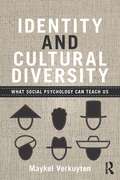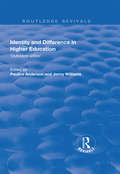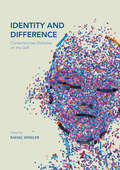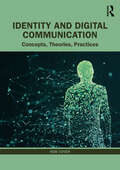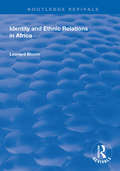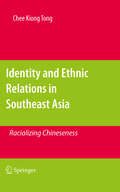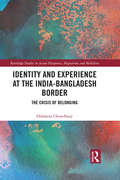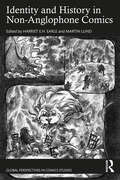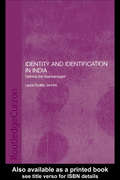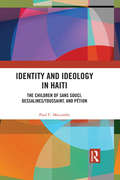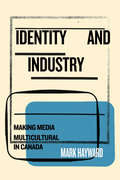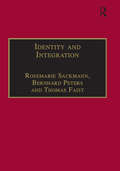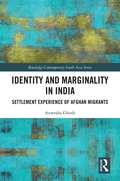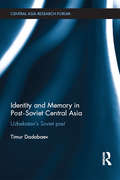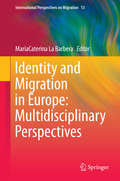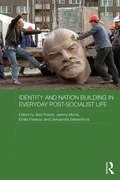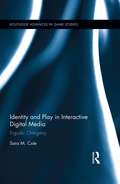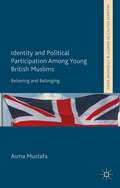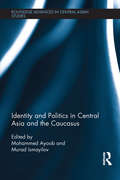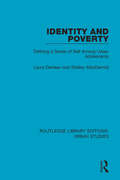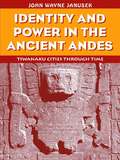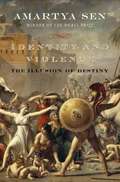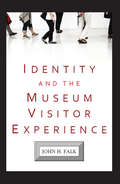- Table View
- List View
Identity and Cultural Diversity: What social psychology can teach us
by Maykel VerkuytenIdentity and Cultural Diversity examines immigration and its effect on diversity from a social psychological perspective. Immigration increases cultural diversity and raises difficult questions of belonging, adaptation, and the unity of societies: questions of identity may be felt by people struggling with the basic problem of who they are and where they fit in, and although cultural diversity can enrich communities and societies it also sometimes leads to a new tribalism, which threatens democracy and social cohesion. The author Maykel Verkuyten considers how people give meaning to the fact that they belong to ethnic, racial, religious and national groups, and the implications this can have for social cohesion. The opening chapters consider the nature of social identity and group identification, and include discussions of identity development in adolescence, acculturation, and multiple and dual identities. Verkuyten then considers one of the most pernicious social problems: how conflict emerges from perceiving others as different. He examines when and why group distinctions grow into conflicts and considers the role of cultural diversity beliefs, such as multiculturalism and assimilation. The book concludes by exploring productive ways of managing cultural diversity. Written in an engaging style, Identity and Cultural Diversity will be essential reading for undergraduate and postgraduate students of social and cultural psychology and other social sciences, and it also makes key themes in social psychology accessible to a wider audience outside academia.
Identity and Difference in Higher Education: Outsiders within
by Jenny Williams Pauline AndersonThis title was first published in 2001. This volume brings together contributions from a group of authors who explore the themes of identity and difference in the context of a range of power relationships within higher education.
Identity and Difference: Contemporary Debates on the Self
by Rafael WinklerThis book provides a persuasive account of how identity and difference factor in the debate on the self in the humanities. It explores this topic by applying the question to fields such as philosophy, cultural studies, politics and race studies. Key themes discussed in this collection include authenticity in Michel de Montaigne’s essays, the limits of the narrative constitution of the self, the use and abuse of the notion of human nature in political theory and in the current political context of multiculturalism, and the feminist notion of the erotic and of sexual violence. This book will appeal to readers with an interest in new perspectives on the self within the humanities.
Identity and Digital Communication: Concepts, Theories, Practices
by Rob CoverThis comprehensive text explores the relationship between identity, subjectivity and digital communication, providing a strong starting point for understanding how fast-changing communication technologies, platforms, applications and practices have an impact on how we perceive ourselves, others, relationships and bodies. Drawing on critical studies of identity, behaviour and representation, Identity and Digital Communication demonstrates how identity is shaped and understood in the context of significant and ongoing shifts in online communication. Chapters cover a range of topics including advances in social networking, the development of deepfake videos, intimacies of everyday communication, the emergence of cultures based on algorithms, the authenticities of TikTok and online communication’s setting as a site for hostility and hate speech. Throughout the text, author Rob Cover shows how the formation and curation of self-identity is increasingly performed and engaged with through digital cultural practices, affirming that these practices must be understood if we are to make sense of identity in the 2020s and beyond. Featuring critical accounts, everyday examples and analysis of key platforms such as TikTok, this textbook is an essential primer for scholars and students in media studies, psychology, cultural studies, sociology, anthropology, computer science, as well as health practitioners, mental health advocates and community members.
Identity and Education: The Links for Mature Women Students
by Janet ParrThis title was first published in 2000: Why do mature women return to education? On the face of it, the answer would seem obvious - to gain qualifications which they had not acquired in their earlier learning. However their return to learning seems to be much more than just about paper qualifications. This book describes the experiences of a number of mature women students who return to learning some time after their compulsory schooling. It looks at the links which the women make between their life stories and their return to education. In particular, it focuses upon a number of women who talk of painful experiences either past or current in their lives - experiences such as manipulative and controlling parents, psychological, physical and sexual abuse, an alcoholic parent, the death of a child or other family members and other difficult life events. These experiences have had a considerable and often ongoing effect on the women’s lives and their return to education seems to be much more than just about paper qualifications. For example, the women talked of confidence, status, proving ability, self respect and independence and what emerged very clearly from their stories was the desire to have some power and control over the way in which their identity was defined. The book breaks new ground in that it makes clear links between the women’s return to education, their past, often very painful experiences and identity. Sometimes the women make very clear connections, but at other times the connections are less explicit, though nevertheless powerful. This is an new area which will contribute to the growing literature on women returners. It will be of interest to lecturers and researchers in many disciplines and will raise awareness of some of the unexpressed reasons for women returning to education.
Identity and Ethnic Relations in Africa (Routledge Revivals)
by Leonard BloomPublished in 1998, this text asserts that psychologists and sociologists have a professional and personal responsibility to further the "cure" of the damage done by governments. The author draws on his own personal experience of living and working in authoritarian, racist or ethnically-sensitive societies and argues that psychologists and sociologists can and should confront their professions and governments by playing an active, collective, therapeutic role in judging the psychological consequences of legal and political practice. The author is concerned with the critical, deconstructionist roles of psychoanalysis and looks at ethnic identity and culture, psychotherapy and mental health problems and the emotional costs and consequences of Apartheid.
Identity and Ethnic Relations in Southeast Asia
by Chee Kiong TongModern nation states do not constitute closed entities. This is true especially in Southeast Asia, where Chinese migrants have continued to make their new homes over a long period of time, resulting in many different ethnic groups co-existing in new nation states. Focusing on the consequences of migration, and cultural contact between the various ethnic groups, this book describes and analyses the nature of ethnic identity and state of ethnic relations, both historically and in the present day, in multi-ethnic, pluralistic nation states in Southeast Asia. Drawing on extensive primary fieldwork in Malaysia, Singapore, Indonesia, Burma, Vietnam, Thailand and the Philippines, the book examines the mediations, and transformation of ethnic identity and the social incorporation, tensions and conflicts and the construction of new social worlds resulting from cultural contact among different ethnic groups.
Identity and Experience at the India-Bangladesh Border: The Crisis of Belonging (Routledge Studies in Asian Diasporas, Migrations and Mobilities)
by Debdatta ChowdhuryThe effects of the partition of India in 1947 have been more far-reaching and complex than the existing partition narratives of violence and separation reveal. The immediacy of the movement of refugees between India and the newly-formed state of Pakistan overshadowed the actual effect of the drawing of the border between the two states. The book is an empirical study of border narratives across the India-Bangladesh border, specifically the West Bengal part of India’s border with Bangladesh. It tries to move away from the perpetrator state-victim civilian framework usually used in the studies of marginal people, and looks at the kind of agencies that the border people avail themselves of. Instead of looking at the border as the periphery, the book looks at it as the line of convergence and negotiations—the ‘centre of the people’ who survive it every day. It shows that various social, political and economic identities converge at the borderland and is modified in unique ways by the spatial specificity of the border—thus, forming a ‘border identity’ and a ‘border consciousness’. Common sense of the civilians and the state machinery (embodied in the border guards) collide, cooperate and effect each other at the borderlands to form this unique spatial consciousness. It is the everyday survival strategies of the border people which aptly reflects this consciousness rather than any universal border theory or state-centric discourses about the borders. A bottom-up approach is of utmost importance in order to understand how a spatially unique area binds diverse other identities into a larger spatial identity of a ‘border people’. The book’s relevance lies in its attempt to explore such everyday narratives across the Bengal border, while avoiding any major theorising project so as not to choke the potential of such experience-centred insights into the lives of a unique community of people. In that, it contributes towards a study of borders globally, providing potential approaches to understand border people worldwide. Based on detailed field research, this book brings a fresh approach to the study of this border. It will be of interest to researchers in the field of South Asian studies, citizenship, development, governance and border studies.
Identity and History in Non-Anglophone Comics (Global Perspectives in Comics Studies)
by Harriet E.H. Earle and Martin LundThis book explores the historical and cultural significance of comics in languages other than English, examining the geographic and linguistic spheres which these comics inhabit and their contributions to comic studies and academia. The volume brings together texts across a wide range of genres, styles, and geographic locations, including the Netherlands, Colombia, Greece, Mexico, Poland, Finland, Portugal, Ireland, and the Czech Republic, among others. These works have remained out of reach for speakers of languages other than the original and do not receive the scholarly attention they deserve due to their lack of English translations. This book highlights the richness and diversity these works add to the corpus of comic art and comic studies that Anglophone comics scholars can access to broaden the collective perspective of the field and forge links across regions, genres, and comic traditions. Part of the Global Perspectives in Comics Studies series, this volume spans continents and languages. It will be of interest to researchers and students of comics studies, literature, cultural studies, popular culture, art and design, illustration, history, film studies, and sociology.
Identity and Identification in India: Defining the Disadvantaged
by Laura Dudley JenkinsCan a state empower its citizens by classifying them? Or do reservation policies reinforce the very categories they are meant to eradicate? Indian reservation policies on government jobs, legislative seats and university admissions for disadvantaged groups, like affirmative action policies elsewhere, are based on the premise that recognizing group distinctions in society is necessary to subvert these distinctions. Yet the official identification of eligible groups has unintended side-effects on identity politics. Bridging theories which emphasize the fluidity of identities and those which highlight the utility of group-based mobilizations and policies, this book exposes didactic enforcement of categorizations, while recognizing the social and political gains facilitated by group-based strategies.
Identity and Ideology in Haiti: The Children of Sans Souci, Dessalines/Toussaint, and Pétion
by Paul C. MocombeUsing a structurationist, phenomenological structuralism understanding of practical consciousness constitution as derived from what the author calls Haitian epistemology, Haitian/Vilokan Idealism, this book explores the nature and origins of the contemporary Haitian oppositional protest cry, "the children of Pétion v. the children of Dessalines." Although traditionally viewed within racial terms – the mulatto elites v. the African (black) poor majority – Mocombe suggests that the metaphor, contemporarily, as utilized by the educated black grandon class (middle-class bourgeois blacks) has come to represent Marxist categories for racial-class (nationalistic) struggles on the island of Haiti within the capitalist world-system under American hegemony. The ideological position of Pétion represents the neoliberal views of the mulatto/Arab elites and petit-bourgeois blacks; and nationalism, economic reform, and social justice represent the ideological and nationalistic positions of Dessalines as articulated by the grandon, actual children of Toussaint Louverture, seeking to speak for the African majority (the children of Sans Souci, the Congolese-born general of the Haitian Revolution) whose practical consciousness, the Vodou Ethic and the spirit of communism, differ from both the children of Dessalines and Pétion. In the final analysis, the moniker is a truncated understanding of Haitian identity constitution, ideologies, and their oppositions.
Identity and Industry: Making Media Multicultural in Canada
by Mark HaywardIn 1947, grocer Johnny Lombardi went on air for the first time to share the sounds of "sunny Italy" with the radio listeners of Toronto. Meanwhile, in cities across the country, a handful of theatres began to show films in foreign languages. In the decade after the Second World War, these events were some of the earliest indications of the nationwide changes taking place in Canadian media as it responded to the new cultural, political, and economic visibility of cultural and linguistic minorities. <p><p>Identity and Industry explores how ethnocultural media in Canada developed between the end of the Second World War and the arrival of digital media. Through chapters dedicated to film exhibition, newspapers, radio, and television, Mark Hayward documents the industrial and institutional frameworks that defined the role of media in Canadian multiculturalism. Drawing on extensive archival research, the book situates late twentieth-century "ethnic" media at the intersection of demand, cultural integration, and the changing economics of popular culture. <p><p>As the development of ethnocultural media continues to shape Canadian society in the age of digital media, Identity and Industry provides richly detailed historical context for contemporary debates about identity and culture.
Identity and Industry: Making Media Multicultural in Canada
by Mark HaywardIn 1947, grocer Johnny Lombardi went on air for the first time to share the sounds of "sunny Italy" with the radio listeners of Toronto. Meanwhile, in cities across the country, a handful of theatres began to show films in foreign languages. In the decade after the Second World War, these events were some of the earliest indications of the nationwide changes taking place in Canadian media as it responded to the new cultural, political, and economic visibility of cultural and linguistic minorities. Identity and Industry explores how ethnocultural media in Canada developed between the end of the Second World War and the arrival of digital media. Through chapters dedicated to film exhibition, newspapers, radio, and television, Mark Hayward documents the industrial and institutional frameworks that defined the role of media in Canadian multiculturalism. Drawing on extensive archival research, the book situates late twentieth-century "ethnic" media at the intersection of demand, cultural integration, and the changing economics of popular culture. As the development of ethnocultural media continues to shape Canadian society in the age of digital media, Identity and Industry provides richly detailed historical context for contemporary debates about identity and culture.
Identity and Integration: Migrants in Western Europe (Research in Migration and Ethnic Relations Series)
by Bernhard PetersSymbolic boundaries, cultural differences and ethnic conflicts have gained significance and new meanings in a global situation characterized by the dissolution of traditional political and societal structures. Communications and political and economic interactions increasingly cross the borders of states, nations and ethnic communities, and yet symbolic borders and separate group identities are nevertheless asserted. The perceived efforts of migrants to maintain their cultural and ethnic identities are often blamed as a cause of conflict within nation states. This intriguing volume recognizes that migrants with an Islamic background are seen as especially problematic cases. Turks are the biggest category among Muslim migrants in Europe and more than one third of all Muslim migrants in Europe are from Turkey. Referring primarily to immigration from Turkey, this book combines both exemplary case studies of Turks within Europe and theoretical papers with innovative perspectives on the relations between integration and identity.
Identity and Marginality in India: Settlement Experience of Afghan Migrants (Routledge Contemporary South Asia Series)
by Anwesha GhoshDecades of conflict and war have forced millions of men, women and children to flee from their homes and seek refuge in other parts of the country or in foreign lands - Afghanistan is one such country. This book is a study of the displaced Afghan migrant population in India, in particular the persecuted Sikhs and Hindus who are religious minorities in Afghanistan and make up a majority of Afghan migrants in India. It explores the relationship between acculturation and identity development. By focusing on the interactions between the Afghan immigrant population and the Indian society, the author analyses how the community negotiates identity and marginality in a country that does not recognize them as refugees. The author explains how the Afghan migrant population manages and negotiates various identities, bestowed upon them by the societies in their home and host countries in their day to day existence in India. An important study of acculturation and adaptation issues of migrant groups in the setting of a developing country, this book will be of interest to academics in the field of refugee and migration studies, ethnography of (ethnic) identity, and Middle East and South Asian Studies.
Identity and Memory in Post-Soviet Central Asia: Uzbekistan's Soviet Past (Central Asia Research Forum)
by Timur DadabaevCentral Asian states have experienced a number of historical changes that have challenged their traditional societies and lifestyles. The most significant changes occurred as a result of the revolution in 1917, the incorporation of the region into the Soviet Union, and gaining independence after the collapse of the USSR. Impartial and informed public evaluation of the Soviet and post-Soviet periods has always been a complicated issue, and the ‘official’ descriptions have often contradicted the interpretations of the past viewed through the experiences of ordinary people. Identity and Memory in Post-Soviet Central Asia looks at the tradition of history construction in Central Asia. By collecting views of the public’s experiences of the Soviet past in Uzbekistan, the author examines the transformation of present-day Central Asia from the perspective of these personal memories, and analyses how they relate to the Soviet and post-Soviet official descriptions of Soviet life. The book discusses that the way in which people in Central Asia reconcile their Soviet past to a great extent refers to the three-fold process of recollecting their everyday experiences, reflecting on their past from the perspective of their post-Soviet present, and re-imagining. These three elements influence memories and lead to selectivity in memory construction, emphasising the aspects of the Soviet era people choose to recall in positive and negative lights. Presenting a broader picture of Soviet everyday life at the periphery of the USSR, the book will be a useful contribution for students and scholars of Central Asian Studies, Ethnicity and Identity Politics.
Identity and Migration in Europe: Multidisciplinary Perspectives
by Mariacaterina La BarberaThis book addresses the impact of migration on the formation and transformation of identity and its continuous negotiations. Its ground is the understanding of identity as a complex social phenomenon resulting from constant negotiations between personal conditions, social relationships, and institutional frameworks. Migrations, understood as dynamic processes that do not end when landing in the host country, offer the best conditions to analyze the construction and transformation of social identities in the postcolonial and globalized societies. Searching for novel epistemologies and methodologies, the research questions here addressed are how identity is negotiated in migration processes, and how these negotiations work in contemporary multiethnic Europe. This edited volume brings to the field a novel convergence of theoretical and empirical approaches by gathering together scholars from different countries of Europe and the Mediterranean area, from different disciplines and backgrounds, challenging the traditional discipline division.
Identity and Nation Building in Everyday Post-Socialist Life (Routledge Contemporary Russia and Eastern Europe Series)
by Abel Polese Jeremy Morris Oleksandra Seliverstova Emilia PawłuszThis book explores the function of the “everyday” in the formation, consolidation and performance of national, sub-national and local identities in the former socialist region. Based on extensive original research including fieldwork, the book demonstrates how the study of everyday and mundane practices is a meaningful and useful way of understanding the socio-political processes of identity formation both at the top and bottom level of a state. The book covers a wide range of countries including the Baltic States, Ukraine, Russia, the Caucasus and Central Asia, and considers “everyday” banal practices, including those related to consumption, kinship, embodiment, mobility, music, and the use of objects and artifacts. Overall, the book draws on, and contributes to, theory; and shows how the process of nation-building is not just undertaken by formal actors, such as the state, its institutions and political elites.
Identity and Play in Interactive Digital Media: Ergodic Ontogeny (Routledge Advances in Game Studies)
by Sara M. ColeRecent shifts in new literacy studies have expanded definitions of text, reading/viewing, and literacy itself. The inclusion of non-traditional media forms is essential, as texts beyond written words, images, or movement across a screen are becoming ever more prominent in media studies. Included in such non-print texts are interactive media forms like computer or video games that can be understood in similar, though distinct, terms as texts that are read by their users. This book examines how people are socially, culturally, and personally changing as a result of their reading of, or interaction with, these texts. This work explores the concept of ergodic ontogeny: the mental development resulting from interactive digital media play experiences causing change in personal identity.
Identity and Political Participation Among Young British Muslims
by Anthony Heath Asma MustafaThis book tackles unanswered questions on British Muslims and political participation: What makes religion a salient 'political' identity for young Muslims (over any other identity)? How do young British Muslims identify themselves and how does it relate to their political engagement? A fascinating insight into the lives of young British Muslims.
Identity and Politics in Central Asia and the Caucasus
by Mohammed Ayoob Murad IsmayilovThe multicultural region of Central Eurasia is living through its early post-independence years and as such serves as an ideal case to study and analyse theories of identity and foreign policy in a non-European context. Looking to re-introduce identity as a multidimensional factor informing state behaviour, this book analyses the experiences of the different Central Eurasian states in their post-independence pursuits. The book is structured into two broadly defined sections, with the first half examining the different ways in which the combination of domestic, regional, international and trans-national forces worked to advance one national identity over the others in the states that comprise the region of post-Soviet Central Eurasia. In the second half, chapters analyse the many ways in which identity, once shaped, affected foreign policy behaviours of the regional states, as well as the overall security dynamics in the region. The book also looks at the ways in which identity, by doing so, enjoys an intricate, mutually constitutive relationship with the strategic context in which it bears its effects on the state and the region. Finally, given the special role Russia has historically played in defining the evolutionary trajectory of the regional states, the book discusses the ways in which Russia itself and its post-cold war policies towards its former colonies have been conditioned by factors associated with Russia’s evolving post-Soviet identity. Placing the region firmly within existing theories of identity and state practices, the book will be of interest to students and scholars of Central Asian Politics, Security Studies, Foreign Policy and International Relations.
Identity and Poverty: Defining a Sense of Self among Urban Adolescents (Routledge Library Editions: Urban Studies)
by Laura DeHaan Shelley MacDermidThis book, first published in 1996, examines an important developmental transition: the formation of identity, as well as the influence that having a well-developed identity may have, on a sample of adolescents living in urban Chicago. This study proposes that identity commitment, exploration, and continuity will be associated with positive psychological and behavioural outcomes for adolescents. This title will be of interest to students of sociology, psychology and urban studies.
Identity and Power in the Ancient Andes: Tiwanaku Cities through Time
by John Wayne JanusekThe Tiwanaku state was the political and cultural center of ancient Andean civilization for almost 700 years. Identity and Power is the result of ten years of research that has revealed significant new data. Janusek explores the origins, development, and collapse of this ancient state through the lenses of social identities--gender, ethnicity, occupation, for example--and power relations. He combines recent developments in social theory with the archaeological record to create a fascinating and theoretically informed exploration of the history of this important civilization.
Identity and Violence: The Illusion of Destiny
by Amartya SenThe 1998 Nobel Laureate in economics, Sen (Harvard U.) responds to what he calls the appalling effects of the miniaturization of people. This happens, he explains, when in order to stop violence, people are reduced to a single identity--for example a moderate Shi'ite or a Hindu nationalist--that authorities believe they can address without considering all the other dimensions of reality each person occupies. Annotation ©2006 Book News, Inc., Portland, OR (booknews.com)
Identity and the Museum Visitor Experience
by John H FalkUnderstanding the visitor experience provides essential insights into how museums can affect people’s lives. Personal drives, group identity, decision-making and meaning-making strategies, memory, and leisure preferences, all enter into the visitor experience, which extends far beyond the walls of the institution both in time and space. Drawing upon a career in studying museum visitors, renowned researcher John Falk attempts to create a predictive model of visitor experience, one that can help museum professionals better meet those visitors’ needs. He identifies five key types of visitors who attend museums and then defines the internal processes that drive them there over and over again. Through an understanding of how museums shape and reflect their personal and group identity, Falk is able to show not only how museums can increase their attendance and revenue, but also their meaningfulness to their constituents.
